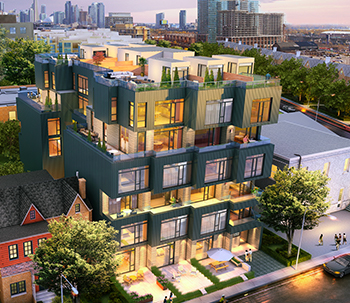David Moses shares three things you should know when building mid-rise with wood. This article was written for Geosolv:
Have you experienced the following scenario? You’ve found a site, you assembled the properties, the zoning looks good, and the price looks just about right for your pro forma. But then you are told there may be some concerns with the capacity of the soils. What now? How concerned should you be? Suddenly all these questions rush into your head: Will I need to pay more for foundation construction? Will I be able to maximize the density on this site? How can I make the purchase with this potential risk?
If this happens to you, here are 3 things you should know that could help you out:
1. Build a Lighter Building
Changes to the Ontario Building Code in 2015 allow taller wood buildings for residential and commercial occupancy. Why does this matter? Wood frame construction is cost-effective (90% of residential construction in Canada and the U.S. is wood frame for this reason). The changes to the building code allow for a 50% increase in allowable height for wood frame structures, which effectively adds 50% more sellable or rentable floor area.
At the same time, a typical wood frame building with underground parking and podium exerts approximately 50% of the load of a concrete building equivalent. If your site has low soil bearing capacity, you should consider switching to wood frame construction to maximize the site density and still be cost effective.
A developer on one site in London, England switched to wood so they could build over an existing sewer: this change allowed them to increase the number units from 21 to 41 by using a mass timber product that resulted in a building double the height with only a 10% increase in loads.
These changes to the building code are being adopted by provinces across Canada.
2. Wood is a Growing Area
Historically, Canadians and Americans have built with wood because it is widely available and very adaptable on site. In British Columbia, where the building code changed in 2009, wood frame construction is between 12% and 15% cheaper than alternatives in steel and concrete for similar buildings. The savings come from reduced material costs and speed of construction. Because taller wood buildings are a new type of construction, not everyone knows how to do it well. The consultants and the builders need the experience to execute a wood mid-rise building correctly and efficiently.
To get the most out of your site and maximize your return on investment, you need a team that understands wood and collaborates from day one.
This includes the builders. For example, when building using prefabricated wood floor panels and wall panels, construction speeds can be increased over stick framing and finishing particularly in sites with tighter access. With the supplier at the table during design, the prefabricated wood wall and floor paneling can be optimized around the supplier’s capabilities to increase your return on investment.
3. Speed up your review time at the city
If your site has poor soil conditions, the building department will want to understand how you plan to address this. City building officials are bombarded with new building code requirements all the time and need time to learn and implement new code requirements.
By including your design team in that discussion they can be shown how taller wood buildings integrate well on sites that require soil improvement.
Ensuring that a collaborative and constructive dialog begins from the outset of the project, even before design begins, can be helpful to reducing the time it takes to get approvals in place. Include your suppliers, your specialty foundation contractor, and a design team who specialize in wood construction in this process – it will pay dividends.
Using a team approach to address building and foundation conditions will help you streamline the approval process, saving you time so you can get in the ground faster.
Summary
Don’t despair if you have a site with poor soil capacity. It may still be a feasible site by reducing the building cost, increasing your sellable area using innovations such as taller wood buildings and ground improvement.
You may have procured the best real estate for your project, now’s the time to assemble the best team!
View the article on Geosolv.
—
Want to learn more about mid-rise wood buildings? Visit us at 6wood.ca.





